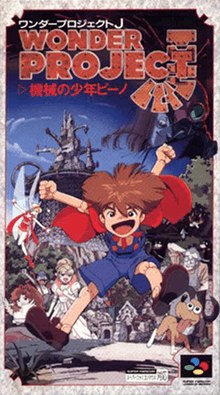Wonder Project J
| Wonder Project J: Kikai no Shōnen Pīno | |
|---|---|
 Cover art | |
| Developer(s) | Almanic |
| Publisher(s) | Enix |
| Director(s) | Takashi Yoneda |
| Designer(s) | Takashi Yoneda |
| Artist(s) | Toshihiro Kawamoto (character design) |
| Composer(s) | Akihiko Mori |
| Series | Wonder Project |
| Platform(s) | Super Famicom |
| Release |
|
| Genre(s) | Life simulation game |
| Mode(s) | Single-player |
Wonder Project J: Kikai no Shōnen Pīno (ワンダープロジェクトJ機械の少年ピーノ Wonder Project J: Machine Boy Pino) is a Japan-exclusive video game published by Enix for the Super Famicom in 1994.
Gameplay
The game is a raising simulation in which the player raises a Pinocchio-esque boy, whose default name is "Pino", to succeed in various challenges and confrontations to activate virtue circuits, with his final task to foster relations between humans and the robot-like Gijin.
Development
The game was developed by Almanic, which also developed the Enix-published E.V.O.: Search for Eden.[1]
Release
The game was released in Japan on December 09, 1994 for the Super Famicom.[2][3] The game was a commercial hit, with sales of 1.3 million units in Japan alone.[4]
Its sequel, Wonder Project J2: Corlo no Mori no Josette, was released on the Nintendo 64 two years later.[1]
The game, and its sequel were ported to the iphone in 2010.[5]
Reception
In April 1995, Famitsu magazine's Reader Cross Review gave the game a 7 out of 10.[6]
References
- 1 2 "Falls from Grace: How Four Creative Game Companies Went Astray from 1UP.com". 2012-11-02. Retrieved 2018-08-15.
- ↑ "ワンダープロジェクトJ -機械の少年ピーノ- [スーパーファミコン] / ファミ通.com". www.famitsu.com. Retrieved 2018-08-15.
- ↑ "ワンダープロジェクトJ~機械の少年ピーノ~ | SQUARE ENIX". www.jp.square-enix.com (in Japanese). Archived from the original on 2017-07-24. Retrieved 2018-08-15.
- ↑ "Japanese RPGs, Page 5". 1997-06-06. Retrieved 2018-08-15.
- ↑ "Wonder Project J2 Heading To iPhone - Siliconera". Siliconera. 2010-04-19. Archived from the original on 2016-09-25. Retrieved 2018-08-15.
- ↑ 読者 クロスレビュー: ワンダープロジェクトJ -機械の少年ピーノ-. Weekly Famicom Tsūshin. No.330. Pg.31. 14 April 1995.